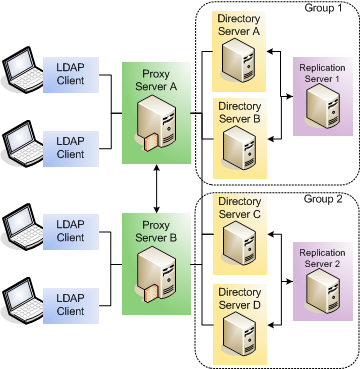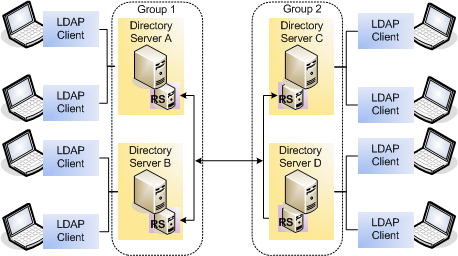6 Updating the Oracle Unified Directory Software
This chapter describes how to update an Oracle Unified Directory directory service to the latest version without a service interruption. It also describes how to update an individual directory server instance and provides considerations for Oracle Directory Services Manager (ODSM) on Oracle Weblogic Server.
The chapter includes the following sections:
-
Section 6.1, "Starting Points for an Oracle Unified Directory Update"
-
Section 6.3, "Updating a Directory Service Without Service Interruption"
-
Section 6.4, "Updating an Existing Oracle Unified Directory Server Instance"
6.1 Starting Points for an Oracle Unified Directory Update
Oracle supports the following starting points for updating Oracle Unified Directory:
-
Oracle Unified Directory 11g Release 1 (11.1.1.5)
-
Oracle Unified Directory 11g Release 2 (11.1.2.0)
-
Oracle Unified Directory 11g Release 2 (11.1.2.1.0)
-
Oracle Unified Directory 11g Release 2 (11.1.2.2.0)
6.2 Considerations for Global Index Catalogs
You cannot update 11g Release 1 (11.1.1.5) or 11g Release 2 (11.1.2.0) global index catalogs that were previously configured using the gicadm command. If you update Oracle Unified Directory to the current release, you must then reconfigure the global index catalogs using gicadm.
For information about configuring the global index catalogs, see Oracle Fusion Middleware Administering Oracle Unified Directory.
6.3 Updating a Directory Service Without Service Interruption
Updating a replicated Oracle Unified Directory topology involves updating the software for each server instance individually. The strategy for maintaining service during an update depends on the specifics of your deployment, but usually, you can update an entire topology without any interruption in service. Because a particular directory server instance must be stopped during the update process, maintaining service during an update requires alternative servers that can handle client requests while a particular server is down.
If your deployment includes one or more proxy server instances that route client requests to the back-end servers, you can safely take down one directory server at a time and update that server instance. The proxy server will reroute client requests to ensure uninterrupted service. Upgrading the proxy server instance requires more than one proxy server instance with the same configuration.
If your deployment does not include a proxy server, you must configure your client applications to send requests to an alternative server while a specific directory server instance is being updated.
The following sections outline the steps to follow for each of these topologies:
-
Section 6.3.1, "Upgrading a Topology That Includes a Proxy Server"
-
Section 6.3.2, "Upgrading a Topology That Does Not Include a Proxy Server"
6.3.1 Upgrading a Topology That Includes a Proxy Server
This section covers these topologies:
6.3.1.1 Upgrading a Topology with the Replication Servers and Directory Servers on the Same Host
In this topology, the directory servers and replication servers are installed on the same host.
If a single host contains both a replication server and a directory server, and those servers are associated with the same ORACLE_HOME directory, the servers are stopped and updated at the same time.
In the following figure, Group 1 and Group 2 refer to configured replication groups. For more information about replication groups, see Oracle Fusion Middleware Administering Oracle Unified Directory.
To update a topology with the directory servers and replication servers installed on the same host:
-
Change the configuration of proxy server A so that client requests are not routed to directory server A.
-
Stop directory server A. The replication server running on this host is stopped at the same time.
-
Update directory server A, following the steps in Section 6.4, "Updating an Existing Oracle Unified Directory Server Instance."
-
Restart directory server A.
-
Test that your directory service is working properly before upgrading successive servers.
-
Repeat steps 1-5 for each directory server in that replication group.
-
Follow steps 1-6 for each replication group in the topology.
-
Stop proxy server A.
-
Update proxy server A, following the steps in Section 6.4, "Updating an Existing Oracle Unified Directory Server Instance."
-
Restart proxy server A.
-
Repeat steps 8-10 for the remaining proxy servers in the topology.
6.3.1.2 Upgrading a Topology wIth Replication Servers and Directory Servers on Different Hosts
In this topology, the directory servers and replication servers are installed on different hosts. In the following figure, Group 1 and Group 2 refer to configured replication groups. For more information about replication groups, see Oracle Fusion Middleware Administering Oracle Unified Directory.
To update a topology with the directory servers and replication servers installed on different hosts:
-
Change the configuration of proxy server A so that requests are not routed to directory server A.
-
Stop directory server A.
-
Update directory server A, following the steps in Section 6.4, "Updating an Existing Oracle Unified Directory Server Instance."
-
Restart directory server A.
-
Test that your directory service is working properly before upgrading successive servers.
-
Repeat steps 1-5 for each directory server in that replication group.
-
Stop replication server 1.
The replication mechanism ensures that directory servers A and B now connect to replication server 2.
-
Update replication server 1, following the steps in Section 6.4, "Updating an Existing Oracle Unified Directory Server Instance."
-
Restart replication server 1.
-
Follow steps 1-9 for each replication group in the topology.
-
Stop proxy server A.
-
Update proxy server A, following the steps in Section 6.4, "Updating an Existing Oracle Unified Directory Server Instance."
-
Restart proxy server A.
-
Repeat steps 11-13 for the remaining proxy servers in the topology.
6.3.2 Upgrading a Topology That Does Not Include a Proxy Server
In a topology that does not include any proxy server instances, you must update your client applications so that they point to an alternative directory server each time you take a directory server down for an update.
The following diagram shows a replicated topology that does not include a proxy server. This topology assumes that the directory servers and replication servers are installed on the same ORACLE_HOME directory.
In this diagram, Group 1 and Group 2 refer to configured replication groups. For more information about replication groups, see Oracle Fusion Middleware Administering Oracle Unified Directory.
To update a topology that does not include a proxy server:
-
Change your client application configuration so that applications do not access directory server A directly.
-
Stop directory server A. The replication server on this host is stopped and updated at the same time.
-
Update directory server A, following the steps in Section 6.4, "Updating an Existing Oracle Unified Directory Server Instance."
-
Restart directory server A.
-
Test that your directory service is working properly before upgrading successive servers.
-
Change your client application configuration so that applications do not access directory server B directly.
-
Stop directory server B.
-
Update directory server B, following the steps in Section 6.4, "Updating an Existing Oracle Unified Directory Server Instance."
-
Follow steps 1-8 for each replication group in the topology.
6.4 Updating an Existing Oracle Unified Directory Server Instance
You can update all Oracle Unified Directory server instances that are associated with a specific ORACLE_HOME directory by installing the updated software version over the existing ORACLE_HOME.
To update an existing Oracle Unified Directory server instance:
-
Download the latest Oracle Unified Directory version from the Oracle Software Delivery Cloud.
For more information, see Section 2.1, "Obtaining the Software to Install Oracle Unified Directory."
-
Stop any Oracle Unified Directory server instances that are associated with the
ORACLE_HOMEdirectory that you are upgrading.On UNIX and Linux systems:
$ instance-dir/OUD/bin/stop-dsOn Windows systems:
instance-dir\OUD\bat\stop-ds.batServers in the topology that are associated with a different
ORACLE_HOMEwill not be updated and do not need to be stopped. -
Follow the steps outlined in Section 2.2, "Installing Oracle Unified Directory."
Where you are required to specify an installation location, enter the same OUD Base Location Home and Oracle Home Directory (
ORACLE_HOME) that you specified for the original installation.For more information about these directories, see Section 1.4, "Understanding the Oracle Unified Directory Installation Directories."
The installer recognizes an existing installation and updates the relevant binary files. Do not recreate the server instances.
-
On Windows systems, manually copy the
start-ds.batfile (located at INSTALL_DIR\bat\start-ds.bat) and replace thestart-ds.batfile of the instances that need to be updated. -
Update any Oracle Unified Directory server instances that are associated with the
ORACLE_HOMEdirectory:Note:
It is mandatory to apply Oracle Unified Directory Bundle Patch 11.1.2.3.1 that is part of Oracle Identity Management Suite Bundle Patch 11.1.2.3.2 (see My Oracle Support for Doc IDs 2067482.1 and 1494151.1) before running thestart-ds --upgradecommand to update the Oracle Unified Directory software from any prior release to 11g Release R2 PS3 (11.1.2.3). Failing to do so might result in an undetermined state.On UNIX and Linux systems:
$ instance-dir/OUD/bin/start-ds --upgrade
On Windows systems:
instance-dir\OUD\bat\start-ds.bat --upgrade
Caution:
If the server instance has large static groups or a large number of total members in all static groups, updating the instance to 11g Release 2 (11.1.2.3) can take some time. Therefore, avoid ending the update (such as usingCtrl-Cto end the process) before it is finished. Ending the update early can leave the server instance in a undetermined state.The output of the
start-ds --upgradecommand is logged in theINSTANCE_PATH/logs/server.outdirectory. -
Restart the server instances that you stopped in Step 1.
On UNIX and Linux systems:
$ instance-dir/OUD/bin/start-dsOn Windows systems:
instance-dir\OUD\bat\start-ds.bat
6.5 Updating ODSM on Oracle WebLogic Server
If you are running ODSM on Oracle WebLogic Server to manage Oracle Unified Directory, consider the following sections:
6.5.1 ODSM Version Requirements
The version of ODSM described in this guide is 11g Release 2 (11.1.2.3). When you update the Oracle Unified Directory software to 11g Release 2 (11.1.2.3), ODSM is also updated to this same release.
Several requirements for using ODSM with Oracle Unified Directory include:
-
You can use ODSM 11g Release 2 (11.1.2.3) to manage only Oracle Unified Directory 11g Release 2 (11.1.2.3.)
-
You cannot use ODSM version 11.1.2.3 to manage previous versions of Oracle Unified Directory, Oracle Internet Directory, or Oracle Virtual Directory. Conversely, you cannot use versions of ODSM shipped with Oracle Internet Directory or Oracle Virtual Directory to manage any versions of Oracle Unified Directory.
Note:
After you update Oracle Unified Directory, you might encounter problems on Oracle WebLogic Server when you try to access the updated version of ODSM. This problem usually occurs if you used your browser to access an earlier version of ODSM. During an update operation, the ODSM URL can change.Therefore, to access the updated version of ODSM, first clear your browser's cache and cookies.
6.5.1.1 Updating Multiple Instances of ODSM
If you have multiple instances of ODSM in your replication topology, consider the following requirements:
-
If you update one ODSM instance to 11g Release 2 (11.1.2.3), you must update all ODSM and replicated instances.
-
If you update ODSM to 11g Release 2 (11.1.2.3), Oracle Unified Directory must be the same version. An updated ODSM version is not supported with earlier versions of Oracle Unified Directory.
6.5.2 Upgrading Oracle WebLogic Server
ODSM 11g Release 2 (11.1.2.3) is compatible with Oracle WebLogic Server 11g Release 1 (10.3.6).
To upgrade Oracle WebLogic Server from an earlier version such as 10.3.5 to 10.3.6, follow the procedure in the Oracle Fusion Middleware Upgrading Oracle WebLogic Server.
If you need to install WebLogic Server, see Section 2.3.1, "Installing Oracle WebLogic Server."
6.5.3 Upgrading the Oracle Application Development Framework (Oracle ADF)
ODSM 11g Release 2 (11.1.2.3) is compatible with Oracle Application Development Framework 11g Release 1 (11.1.1.9).
To upgrade Oracle ADF from version 11.1.1.5 or 11.1.1.6 to version 11.1.1.9, follow the procedure in the Oracle Fusion Middleware Patching Guide.


